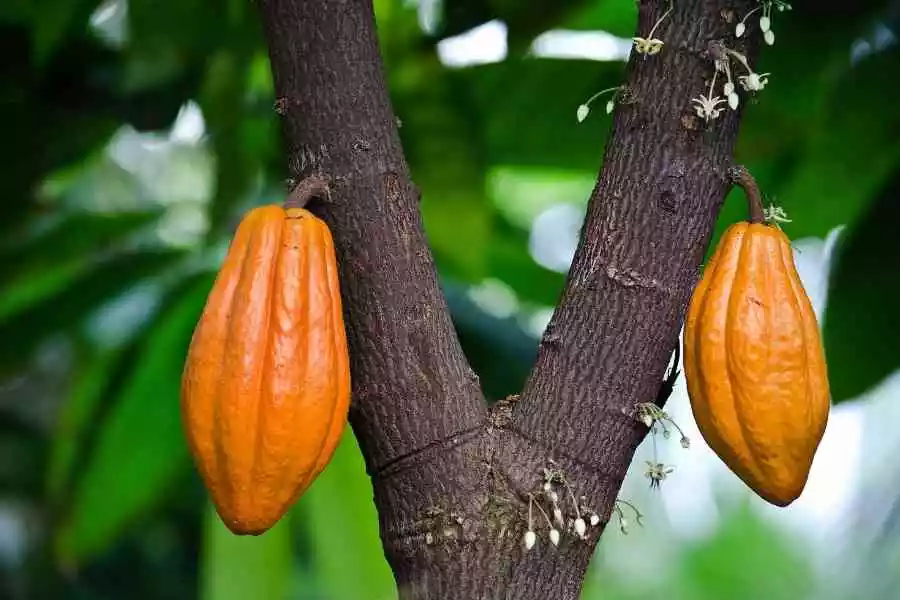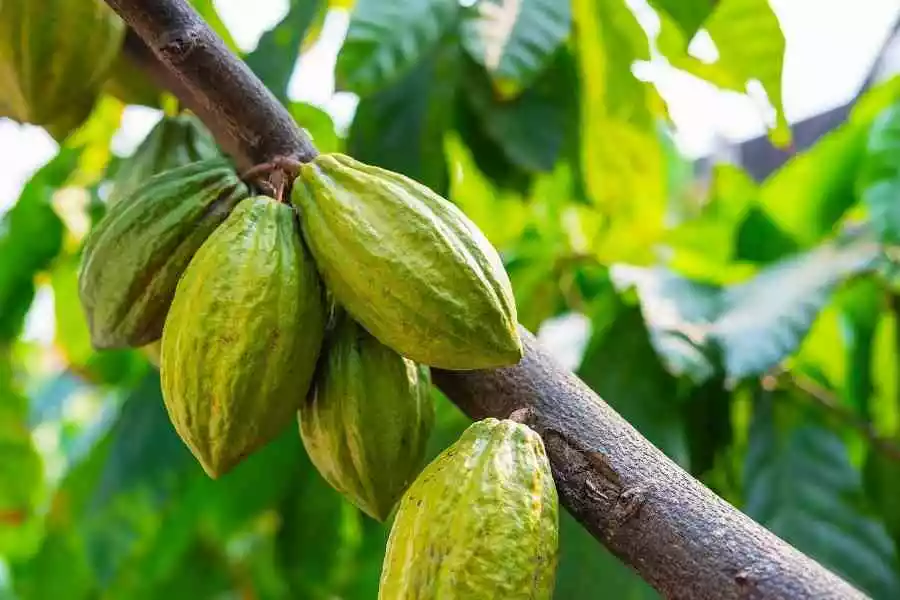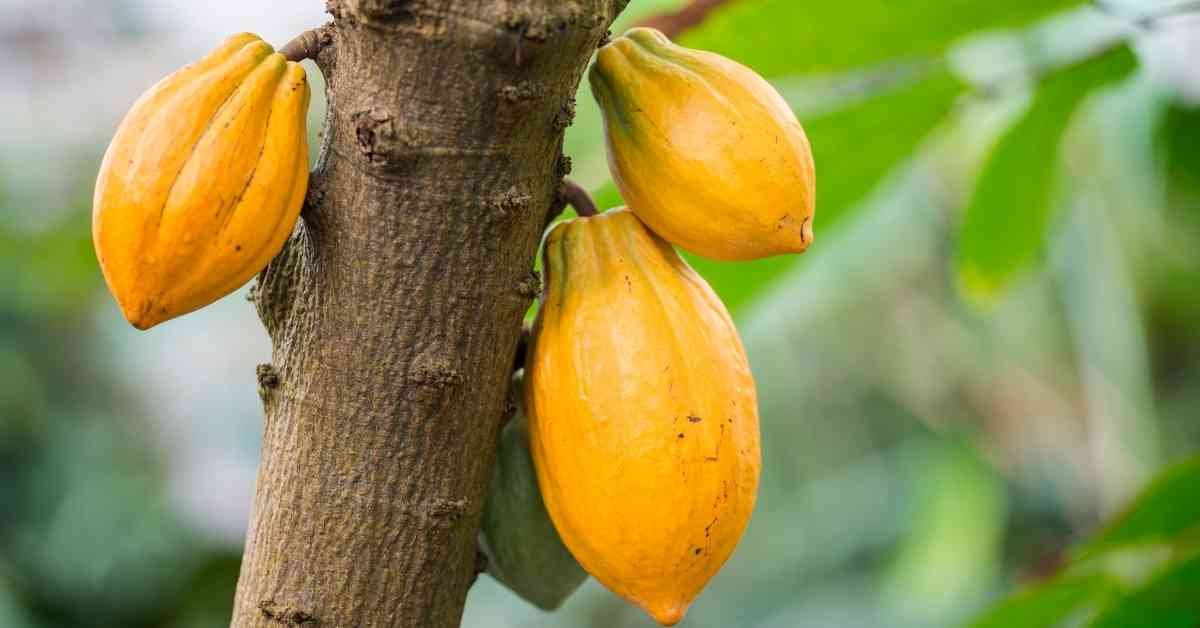In this blog post we will cover the step-by-step process on how to grow cocoa tree commercially. You will learn about the site selection, planting, care and maintenance of the cocoa trees. Follow these simple steps and you will be able to enjoy a successful cocoa crop. Happy growing!
How to Grow Cocoa Tree Step-by-step
The cocoa tree is a native of Central America, although it is currently planted all over the world in tropical areas. The tree has huge, glossy, dark green leaves and can grow up to 20 feet tall. A fruit with a pod-like form and seeds that are used to manufacture cocoa powder and chocolate is produced by the cocoa tree.
The tree also has a robust root system that aids in ground anchoring and shields it from wind harm. Cocoa trees are dependent on the weather in their growing location because they need moderately high temperatures and lots of rain to thrive.
The trees are also vulnerable to pests and illnesses, which may lower the cacao bean quality. Despite these difficulties, many nations still depend heavily on the cocoa tree as a source of income, and people all around the world continue to savor the wonderful fruit it produces.
- Botanical Name: Theobroma cacao
- Family: Sterauliaceae.
Origin:
- It originated in Central America and parts of Mexico.
Importance
The main uses of cocoa are food, medicinal or therapeutic purposes, cosmetics, and peat mulch alternatives.
- Cocoa aids in lowering blood pressure (BP) and improving the elasticity of blood vessels.
- Cocoa beans have excellent antioxidant properties.
- Cocoa is good for brain health.
- Cocoa lowers blood cholesterol (lowers TGCL and LDL).
- Cocoa prevents neurodegenerative disorders.
- Cocoa aids bronchial asthma patients.
- Cocoa helps in fighting with obesity.
- Copper deficiency and magnesium deficiency can be prevented through cocoa consumption.
- Cocoa prevents chronic fatigue syndrome (CFS).
- Cocoa is good for skin.
Variety
- Forastero variety: CCRP-1, CCRP-2, CCRP-3, CCRP-4, CCRP-5, CCRP-6, CCRP-7.
- Hybrid: VTLCH1, VTLCH2, VTLCH3, and VTLCH4CCRP: 8, CCRP: 9, CCRP: 10.
Climate
- Cocoa bean trees can be cultivated at altitudes up to 1150 meters above mean sea level (MSL).
- The cocoa crop requires an average annual rainfall of 1000 mm to 2000 mm.
- Relative humidity of 80–85%
- The maximum temperatures required for its cultivation are 34 °C.
- The minimum temperatures required for its cultivation are 14 °C.
Soil
Cocoa trees can be grown in a wide range of soils. Cocoa trees are predominantly cultivated in red laterite soils. However, these trees prefer well-drained clay, loam, or sandy loam soil with a pH range of 6.5 to 7.0. Water-retaining soils are best for their optimum growth and yield.
Propagation
Propagation of cocoa is done through seeds and vegetative cuttings.
Seed propagation:
In the seed propagation of cocoa, seeds should be treated with ash or lime. Cocoa seeds should be sown in polythene bags. These seeds can be raised in nursery beds with the required shade. Seeds were sown soon after extraction.
Seedlings of 60 cm height should be ready for transplantation in the main field. For better germination, make sure to sow the seeds whose pod husk thickness is less than one centimeter and bean (dry) weight is more than one gram.
Vegetative Propagation:
Cocoa trees may be propagated by vegetative cutting, budding, or grafting. In vegetative propagation, to achieve 90% rooting, use cuttings 3 to 4 cm long with 1 or 2 leaves on them, treated with IBA, and planted in a medium of rotten palm fiber and sand in equal parts.
Generally, tree cuttings of 15 cm length bearing four terminal leaves should be treated with NNA + IBA dip and planted in poly bags; this will result in a rooting rate of 65–75% after one month.

Land Preparation
Land should be prepared by giving 3–4 plowings until the soil attains a fine tilth stage. As this crop requires well-draining soil, the land should be prepared in such a way that the water will drain quickly.
Planting and spacing
Cocoa plantations depend on the cultivar and method adopted. However, the flocking shows the recommended spacing when the cocoa is grown as an intercrop. Basically, cocoa is a shade-loving plant, and natural or artificial shade should be created during its seedling period and growing period. Cocoa requires more shade in the initial stages of growth than in later stages of growth.
| Main Crop | Inter Crop | Spacing (m) | Cocoa Plant/ha |
| Coconut | Cocoa | 7.5 X 7.5 | 500 |
| Arecanut | Cocoa | 2.7 X 2.7 | 686 |
| Oil palm | Cocoa | 4.5 X 4.5 | 400 |
Selection of planting materials
When seedlings are used as planting material, select vigorous and healthy seedlings from the polyclonal garden. The planting material should be a 4–6-month-old seedling, grafted, or budded plant. The seedling, grafted, or budded plant should be planted in the center of the pit, not too deep. While planting grafts, the polythene strip tied over the graft joint should be removed, and the joint should be above the soil.
Manures and Fertilizers
The cocoa plant responds very well to organic manures and fertilizers. Any nutrient or micronutrient gaps should be filled during soil or land preparation.
On average, each cocoa plant requires
- FYM: 8 to 10 kg/year.
- N: 100 g/year.
- P2O5 40g/ year.
- K2O: 140 g/year
These fertilizers should be applied in two equal split doses, one in April–May and the other in August–September. Organic manures should be applied in the first year itself. 1/3 of fertilizers should be applied in the first year, 2/3 in the second year, and the full dose should be applied in the third year.

Pruning
Pruning is the process of thinning branches and removing old or dead stems or branches. This is mandatory in most farm management practices to allow the crop to grow well by allowing direct sunlight. Pruning in cocoa cultivation should be carried out twice a year.
Pruning is done to encourage a tree’s structure or control the height that allows sunlight. Carry out the first pruning after the main harvest just before the monsoon. A second pruning should be done six months after the first one. Any lower branches and dead branches should be removed. Limit the branches from 4 to 5 for better sunlight. Burn any diseased branches after they are removed.
Irrigation
Proper irrigation of cocoa plants ensures healthy growth and yield. Since cocoa plants are susceptible to drought, constant moisture should be maintained. During the summer, when the weather is hot and dry, you should water young cocoa plants every three days.
It does not require any watering in the rainy season. In case of floods and heavy rains, make sure to drain out the water from fields as soon as possible. Adopting drip irrigation is the best method of using water effectively. Even applying fertilizers through drip is possible for better utilization of fertilizers and controlling weed growth.
Pests and disease
In any crop, pest and disease control play a major role in getting quality produce and higher yields. The following are the main pests and diseases found in cocoa cultivation:
Pests: The following are common pests found in cocoa cultivation: mealy bugs, aphids, plant hoppers, caterpillars, mosquitoes, cocoa pod borer, and stem girdlers.
Diseases: The following are common diseases found in cocoa cultivation: cocoa swollen shoot, seedling blight, witch’s broom, black pod, frosty pod, stem canker, and wilt.
Control
- Spraying of Neem Oil 3% or Fish Oil Rosin Soap 25 g/liter
- Spraying of dimethoate at 2 ml per liter
- Spraying imidacloprid (0.6 ml/lit), thiamethoxam (0.6 g/liter), profenophos (2 ml/litre), and carbaryl (2 g/lit).
- Spray a 1% Bordeaux mixture or 0.2% copper oxychloride on seedling blight just before the monsoon starts and then often after that.
- Remove the infected pods.
- Remove and destroy the affected seedlings.
Harvest and Threshing
Cocoa trees start flowering in the tin thehirdafterear of or owing/planting. Actual economic yield starts from fifth year. Cocoa pods mature in about 5 to 6 months. Usually, cocoa produces two main crops in a year. Usually, one can judge the maturity of pods by color change. Generally, green pods turn yellow when mature. Make sure to harvest at regular intervals of 10–12 days. Do not allow the pods to be overripe. The pods are opened by heating them on a hard surface or using a mallet.
Post-Harvest Handling
Once harvesting is done, pod fermentation should be carried out. Afterwards, pod breaking should take place, and you may get 30 to 35 wet cocoa beans per pod. These beans should go through fermentation and drying. Dried cocoa beans should be graded, packed, and stored.
Yield
- On average, 50–70 pods are produced annually and per tree.

Verdict
In conclusion, growing cocoa trees commercially is a viable option for those looking to get into the agriculture industry. It is important to remember that it takes time and dedication to grow a successful cocoa plantation, but with hard work and proper planning, you can be on your way to becoming a cocoa mogul. Have you ever grown cocoa trees commercially? What was your experience like? Let us know in the comments below.
